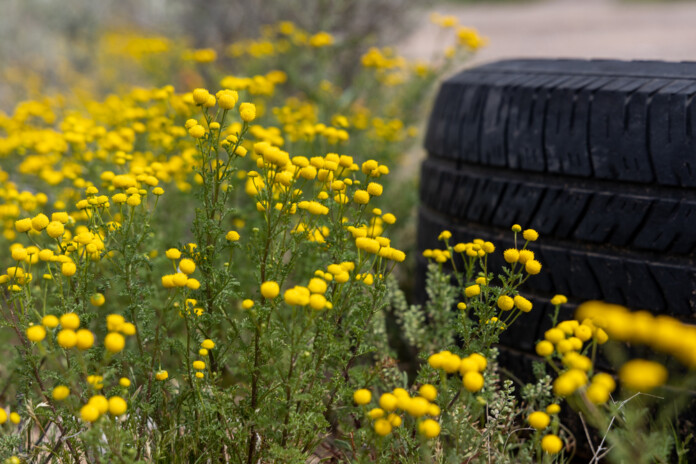
Have you seen that vibrant explosion of yellow surrounding Maricopa? While the flower may be nice to look at, it is invasive, and quite literally stinks, hence the name.
Stinknet (Oncosiphon piluliferum) is an invasive weed that has become a significant problem in Arizona and other parts of the southwestern U.S. According to Michael Chamberland, of the University of Arizona cooperative extension, the plant is native to South Africa.
Up close, the plants are spherical, another reason for their alternate name “globe chamomile.” Each sphere is made of many tiny yellow flowers, each with potential to form one seed.
The weed has a strong, pungent odor when crushed, similar to turpentine. It has small, barbed seeds that can attach to clothing and animal fur, helping it spread.
The first published account of the weed in Arizona was reported in spring 2005, which was especially wet, similar to weather experienced this February and March.
“They will germinate in large numbers during wet winters,” Chamberland said, adding that winters of 2021 and 2022 were drier, with fewer and smaller Stinknet plants.
Aside from the plant’s stench, they kill native wildflowers.
“Stinknet forms dense patches or drifts of vegetation, which can overtop and smother native wildflower diversity,” Chamberland said in “Stinknet: a Weed Advancing in Southern Arizona.”
As most desert-dwellers know, native plants usually are widely spaced to compete for rainwater. Stinknet tends to fill those gaps.
The weed also can become a fire hazard as the Arizona desert summer heat returns.
When Stinknet is dry, plants become a “flash fuel,” easily ignited by sources like a cigarette, and could cause a larger fire by igniting bushes and trees.

![Maricopa’s ‘TikTok Rizz Party,’ explained One of several flyers for a "TikTok rizz party" is taped to a door in the Maricopa Business Center along Honeycutt Road on April 23, 2024. [Monica D. Spencer]](https://www.inmaricopa.com/wp-content/uploads/2024/04/spencer-042324-tiktok-rizz-party-flyer-web-218x150.jpg)



![Locals find zen with Earth Day drum circle Lizz Fiedorczyk instructs a drum circle at Maricopa Community Center April 22, 2024. [Brian Petersheim Jr.]](https://www.inmaricopa.com/wp-content/uploads/2024/04/PJ_3922-Enhanced-NR-218x150.jpg)


![Shred-A-Thon to take place tomorrow An image of shredded paper. [Pixabay]](https://www.inmaricopa.com/wp-content/uploads/2024/03/shredded-paper-168650_1280-218x150.jpg)



![Alleged car thief released without charges Phoenix police stop a stolen vehicle on April 20, 2024. [Facebook]](https://www.inmaricopa.com/wp-content/uploads/2024/04/IMG_5040-218x150.jpg)



